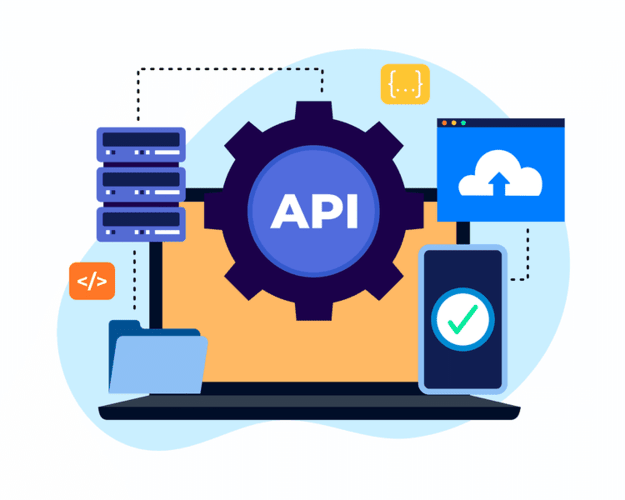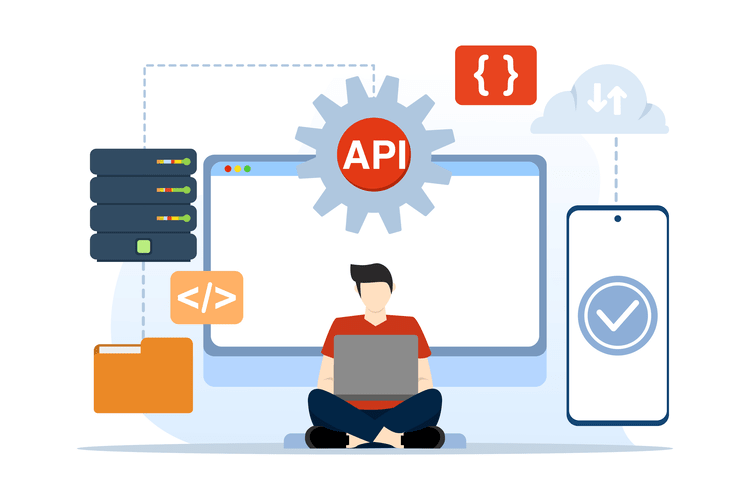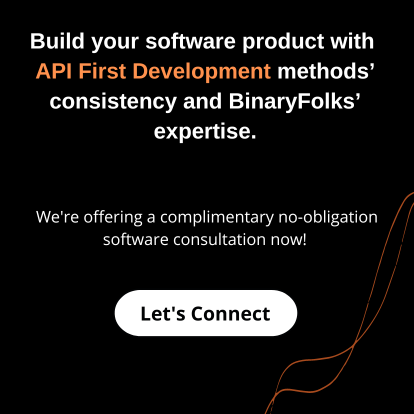API first development is quickly becoming the preferred foundational approach for most organization-wide projects, be it for the internal or external use cases. In this blog, we will discuss how this development method allows your business to leverage the benefits of establishing an API design first and then building your project on top of it.
“API-first development is the process of building APIs first without dedicating a single line of code towards an application”. This is the rudimentary definition you might have come across while discussing this approach from almost every possible source. While the statement stands correct are you sure this answers everything you need to know about the process? Guess not!
Questions like – “How does it help my project?”, “Will it make my development life cycle longer than a traditional approach?”, “Do I need a special team of adept API Developers to finalize the blueprint for my project?”, and above all – “Will it make me money?” are barely answered by an individual discussing these topics. Until now.
But before we find the answer to these questions, let’s first discuss the API-first approach in a more elaborate and objective-driven manner.
What is an API?
Before dumping a load of information discussing a development approach that involves API, it’s only fair that we take a step back and talk a little bit about what API really is, just to make sure all of us are on the same page! Technically an Application Programming Interface (API) is a set of defined functions that decide how your application will interact with external applications or access the resources provided by external sources.
Let’s say you want to order something at a restaurant. Instead of going and finding your way to the kitchen by yourself, you let your waiter know what you want. The waiter takes your order to the kitchen and delivers it back to you. An API is just like a waiter. It acts as a middleman between two applications and allows them to communicate with each other without needing them to know the inner workings of the other party.
Now think, would you like to decide your menu, call your customers, and then figure out how to deliver the orders to your customers? Or, would you like to have an efficient waiter system in place first, who very well knows how different customers might like to place orders and then open the restaurant? That’s exactly the question we are here to answer.
What Does the API-First Development Approach Actually Mean?
Building traditional software often involves building the different components of the software first and then connecting them to make sure they communicate efficiently. In the case of the API-first approach, we plan and build the connection points of the app first, which decides how the different parts of the application will connect and exchange information. Once these connection points are established we build the individual app features knowing exactly how they'll plug in and work together. So, instead of building the different parts of the software in isolation and then figuring out how to connect them later, API-first lets you build everything with a clear understanding of how it will all work as a whole.
Simply put, practicing the API-first approach means sitting with everyone involved in the project(developers, stakeholders and others) and drafting a comprehensive map of the project. Think of it this way, every team within your organization knows their part of the job, right? They know what they are expected to deliver and how that is going to come across in the end. With that piece of knowledge from every team involved, we start describing the fundamentals of the API framework like – data formats, endpoints, authentication and other mechanisms for the entire project. Such that, by the end of this process, everyone involved with the project is on the same page about how their data is expected by the other parts of the project that they will be collaborating with, allowing them to develop their part of the solution accordingly.
“But wouldn’t that just inflate the planning stage of the project by a solid percentage?” – Well yes, but it balances out!
Build Your API with BinaryFolks
Will API-First Approach Be – Too Much Work?
Sure it looks like too much work initially, but historically, if you have found yourself in between a large-scale project like we have, you would know how messy things get as the development phase reaches a closure.
Incompatibility of the data outputs, lack of configuration to connect the endpoints, red flags in the overall security due to inconsistent authentication protocols- it all piles up to essentially cost you more resources compared to what you would spend in the initial planning phase. But just because it occurs during the longest(read: development) phase of any project cycle, it always manages to fly under the alert radar.
“But why would we want to make a complete 180 turn in the development process just to save some extra time?” – That isn’t the only benefit you get when opting for this approach.
What are the Benefits of API-First Development Compared to Regular Development Cycle
The ROI on opting for this approach may not radiate at the very beginning but as the project matures the value of this approach starts to come under the spotlight. How? Let’s discuss that and a few more ups of API-first driven development process down below –

[A] API Becomes a Product
When the API is developed while addressing the complete project roadmap and has the input of the entire team from the get-go, the end product acts less like a basic communication layer and behaves more like an actual product. Something that can be referred to again and again across various business verticals. Heck if you build these with a wider audience in mind maybe you could even white label it for some extra revenue! While it may not be the biggest concern for most of your readers right now but hear me out, just in case… While every business is unique and needs a specific combination of features and add-ons to their software to make their own identity in their respective industries. The core of many businesses remains the same. This is where the idea of converting your developed API into a product has a solid use case.
While it may not be the biggest concern for most of your readers right now but hear me out, just in case… While every business is unique and needs a specific combination of features and add-ons to their software to make their own identity in their respective industries. The core of many businesses remains the same. This is where the idea of converting your developed API into a product has a solid use case.

[B] Efficiency Skyrockets During the Development Phase
As remotely mentioned in the previous point, the re-iterative ability of the API first approach is not just effective across different businesses with similar core functionalities. These APIs can be replicated and integrated with various sections of your own business where you can identify a similar use case.
For instance, consider you’ve got an e-commerce business. And let’s say you planned and built an API framework for the client-facing website with the core functionalities enabled, such as – product listing, automated offer updation, user account management and others. Now, by replicating this framework along with some minor tweaks you can use the same for – a behind the scene inventory management system, or, maybe a mobile version of the application! And since the standard format was already finalized by various departments, the newly created API frameworks will easily fit into the project model. Contrary to building these frameworks separately from scratch for every single spot where it was necessary.

[C] Boosts the Product Quality by Maintaining Consistency
“So basically, it saves time and I might generate some revenue out of it if I have a unique and broad perspective.” – Well yes, but that’s not all, let me explain…. Think of the traditional method we just discussed. If that were to be the case, 3 different teams would be building something similar in their own sections with 3 different teams bringing 3 different combinations of skills. At this point, isn’t it quite obvious the final product will have 3 modules performing similar actions but in different styles? – “That does not sound very convenient” – Exactly!
In the future, if the solution is assigned to a third person, looking at this scenario, they would naturally feel like a chef who has been provided 3 different recipes for the same dish. It is only natural that the new developer won’t be able to maintain the best quality of service across 3 different modules, unless you assign 3 people on the job. Alternatively, if the solution is able to maintain consistency across these different verticals, the quality of the service and the efficiency provided by anyone in the future will be parallelly better.
As the solution's ability to surface new bugs will go down, considering, if you were able to resolve one such bug for a single API framework you can simply replicate it across all of the implemented areas if the bug ever reappears.
What Does an API First Approach Focused Development Look Like
Here is a step-by-step roadmap of what an API first Development cycle looks like. Things start-off as you –

[1] Sit with the Stakeholders and Devs
Like the inception of any successful project, the single most important thing for you to consider is – the need of every single individual who’s going to leverage the solution after it is developed. The best way to do this on a company level is to bring together all of the stakeholders and the developers from the different parts of the company and understand their use cases one by one.
With that information acquired, you can finalize the initial roadmap of the project. Finalize points like –
- “What are the types of APIs that will be necessary?” – Depending on the different use cases.
- “Will an API client be necessary for the solution?” – In case the API will be used by individuals with limited technical expertise.
- “What will the endpoint layout of the project look like?” – To scope-bind the complexity of the project.
With these and many more equally relevant and crucial points finalized, we can go ahead and map out the entire API framework and get it approved by all of the parties involved.

[2] Choose API Specification Language
With the project framework pretty much finalized the next important discussion comes down to the technical aspects of the project. Is your project requirement inclined towards an elaborate and feature-rich API framework? Do you wish to make the syntax simplified and easy to read? Are you working with a specific set of tools prior to the development of the framework and want the new API to work with it seamlessly? All of these scenarios call for the implementation of various different API languages. For example:
With that information acquired, you can finalize the initial roadmap of the project. Finalize points like –
- OpenAPI(Swagger): If you want an API specification language that is focused on elaborating and defining upon RESTful APIs specifically then OpenAPI(formerly known as Swagger would be a popular option)
- RAML: Similarly, if your business needs to thoroughly document each and every aspect of the API framework being built then RAML is a popular API specification language you can go for.
- GraphQL: In case your project has layers of complicated data relationships across various business verticals. And you expect to query your data before using it for the business processes then GraphQL should be your go-to choice.

[3] Complete the API Contract
With the business and technical requirements mapped out, the final step of the planning phase comes down to joining the dots and developing a final API contract consisting of a well documented API frameworks and API design with all of the necessary details. Along with the vital security protocols and certifications including –
- Authentication and Authorization: Implementing strong authentication protocols (eg: OAuth), and authorization mechanisms(eg: RBAC).
- SSL/TLS certifications: Install certifications on the servers hosting your API(eg: by purchasing it from companies like Sectigo SSL certificate for your website or other products) and TLS certifications to secure your connection.
- Security Testing: Practice regular security analysis protocols (eg: penetration testing, vulnerability scanning, etc.) to identify and resolve any potential weaknesses.
Preferably this contract should follow a widely accepted format, making it easier for all of the parties involved with developing your API to refer to.
This step allows stakeholders to take a step back and analyze the overall layout of the product, and give a final confirmation that the API is indeed the way they want it to be. Making a change after the development has started may lead to a complicated final product, which makes this step extremely crucial for the final success of the product.

[4] Discuss and Establish a Style Guide If Necessary
Well, developing an API style guide is not your typical UI-designing phase that you might find in a standard software development project. Instead, it is focussed on maintaining a consistent architectural format across various parts of the API (presumably being developed by different teams). So factors like the endpoint-correlations, naming conventions, data formats, error handling protocols are standardized in this step. And everyone involved with the project must strictly follow these guidelines to make sure that even though different teams are developing the solutions from different perspectives, once the final product is developed it acts consistently throughout.
So, although not directly associated with the visual looks and UI of the final product, the style guide acts as a crucial tether that connects the UI with the required backend areas and ensures proper overall functionality.

[5] Establish the API Foundation
This is the point where everyone associated with the development of the project can come together and implement the entire blueprint that was developed in the last 4 steps. Based on the API contract the project is broken down into a number of milestones, upon completion of each milestone a new version of the API framework is released that is tested by the developers and QA experts first, and then passed onto the stakeholders to try and provide their feedback and add suggestions (if necessary).
It is very crucial to document the changes being made across each and every step as it will be the first reference point in case the API runs into an issue between any two versions. The devs can easily tally the changes made between the recently launched version and the version prior to it, and identify the cause of the issue with ease. This minimizes the troubleshooting time and ensures that the precious development time is not wasted behind these arrears.

[6] Test and Deploy the API
The best practice here is to test the API after the completion of each and every milestone to make sure any issues are identified and resolved as soon as possible. To make sure this happens in the most efficient way possible developers choose to automate the testing process wherever possible. With proper test scripts, real-world scenarios can be replicated allowing devs to define various requests and payloads. In case any irregularities or issues are noticed the test case is flagged and the devs can troubleshoot it to find the cause behind it.
Additionally, if the team has additional time to spare, a few rounds of manual testing should also come across to help identify any corner cases that the automation tool might not be covering. Once that’s done the API developed is ready to deploy.

[7] Replication and Implementation According to Requirement
Now the final step before you complete the development cycle is to go through the project mapping and identify the places where an already developed API can be replicated and implemented. The devs just need to make some minor tweaks to the endpoints and other factors and implement the API to the new location within the solution.
This not only cuts down the development cost and time by a significant amount, but also helps bring down the overall complexity of the overall API network design.
Conclusion
With all the information you have gathered regarding the API-first development method, you must be able to finalize what approach you are going to take for the development of your business solution. The primary point of introspection for you right now is to analyze the ROI of the API first method, are the benefits resonating with your business model? Or you don’t see the same value in implementing it in your business and feel like a traditional software development cycle will do “just fine”? Or, you’re having a hard time taking a decisive call?
In any of the above cases, feel free to reach out to our development consultation team from the button down below to get a complimentary session where we schedule a meeting to understand your business model. Only after our experts get a firm understanding of how your business operates, we will suggest you the best possible approach for your specific scenario. Looking forward to hearing from you!
Get Complimentary Consultation from Experts!
FAQs
Microservices are designed as independent applications that are loosely connected to each other within a software architecture. And the connectivity is provided by the API-first design making both Microservices and API-First extremely relevant and compatible with each other.
Code-first API development can be considered as the traditional way of developing APIs where the core functionalities of the software is developed first and the API is developed based on these functionalities.
Contract-first API development is what is also commonly known as API-first development where the data format, endpoints, and the overall API design are decided first, and only then the primary functionalities are developed, preferably in the form of microservices.
Depending on the complexity of the API being developed the time required for the integration can fall anywhere between 1-3 weeks for simple integrations. Whereas complicated integrations can take as long as 6-8 weeks or even more depending on the exact requirements.
In case your requirement is to design and implement a very simple API with minimal endpoints and a common database, then you're probably looking at a development cost of $10,000 – $20,000. However, as the complexity of the project skyrockets, the development cost of a reliable and seamless API structure can cost up to $50,000 or more, depending on your exact needs.





